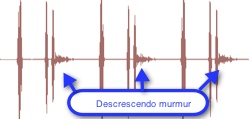Heart Murmurs
Heart Murmur Definition
Heart murmurs are sounds produced by turbulent blood flow, particularly from the heart's valves. They can be found in infants or develop later in life. Innocent murmurs frequently resolve without treatment. However, other abnormal heart murmurs indicate a cardiac condition.
Heart Murmur Audio
This website uses both patient recordings and simulated heart sounds for training, drills and quizzes. Of course in real life you will use a stethoscope to listen to heart sounds. Normal heart sounds follow a "lub-DUB" pattern. The lub and dub, which are the sounds of your heart valves closing. In some abnormalities, the "lub-DUP" sound pattern changes with additional sounds being heard.
Cardiac Auscultation
On this website, we provide lessons, reference guides and quizzes for cardiac auscultation of murmurs and other heart sounds. This includes gaining an understanding of cardiac rate and rhythm, conditions of the valves and possible anatomical abnormalities such as congenital defects. Links to our lessons, guides and quizzes are found in the 'Quick Links' box to the left.
Heart Murmur Sound Types
Heart sounds can include multiple sound components.
- S1: The first heart sound, a low-pitched sound caused by the closing of the mitral and tricuspid valve.
- S2: The secound heart sound, caused by closing of the aortic and pulmonary valve.
- S3: An extra heart sound. S3 is a ventricular gallop, a low-pitched sound that can follow S2.
- S4: An extra heart sound. S4 is an atrial gallop, produced by the atria forcefully pushing blood into a stiff ventricle.
- Systole: The period between S1 and S2, when the ventricles contract.
- Diastole: The period between S2 and the beginning of the next heart beat (S1). Ventricles are relaxing.
- Clicks: These are short, higher-pitched sounds.
- Rubs: A creaking, leather-like sound, typically heard during systole.
Timing and Cadence
Systolic murmurs occur between the first heart sound (S1) and the second heart sound (S2). Diastolic murmurs occur between S2 and S1. In addition, timing is used to describe when murmurs occur within systole or diastole. For example, early systolic, midsystolic or late systolic.
Heart Auscultation Points
Where To Auscultate Heart Sounds
Heart auscultation is performed over five sites on the anterior chest wall. Use the stethoscope's diaphragm, switching to the bell to hear lower pitched sounds.
Heart Murmur Sites
The recommended heart murmur auscultation point is indicated by an icon and text within each of our lessons. Using these auscultation positions can help in evaluating the heart sound or murmur's source.

 |
Aortic Valve Area | Second right intercostal space (ICS), right sternal border | |
 |
Pulmonic Valve Area | Second left intercostal space (ICS), left sternal border | |
 |
Erb's Point | Third left ICS, left sternal border | |
 |
Tricuspid Valve Area | Fourth left ICS, left sternal border | |
 |
Mitral Valve Area | Fifth ICS, left mid-clavicular line |
Duration
Heart murmur duration refers to the portion of systole or diastole that the murmur occupies. Terms used include short and long. Murmurs lasting throughout systole are referred to as holosystolic or pansystolic.
Pitch
Evaluation of the murmur's pitch should be made by classifying the pitch (frequency) as low, medium or high. The stethoscope's bell can be helpful with low-pitched sounds while the diaphragm is used for medium or high-pitched sounds.
Shape
Some murmurs are described by the sound's shape. Common classifications include crescendo (increasing intensity), decrescendo (decreasing intensity), crescendo-decrescendo (increasing then immediate decreasing intensity). Crescendo-decrescendo is also called diamond shaped. Rectangular, also termed plateau indicates a heart murmur of constant intensity. Our lessons include waveforms that illustrate these shapes.


Tonal Quality
Listen for additional aspects of the murmur's sounds. Heart murmurs may have qualities that can be noted as musical, harsh, blowing, booming, sharp or dull.
Respiration and Patient Position
Respiration or patient position can influence murmur intensity as well as heart sound splitting. These factors will be described within the heart sound lessons. Generally speaking, murmurs increasing with expiration originate with left side (aortic or mitral) valves, while murmurs increasing in intensity with inspiration originate with tricuspid or pulmonary valves.
Within each lesson, the author provides a sketch of the patient's position during auscultation, such as supine, left lateral decubitus, squatting or sitting.


